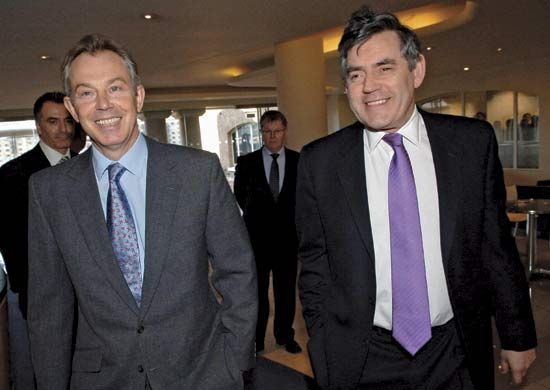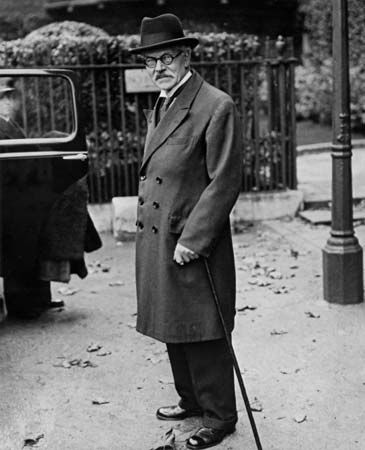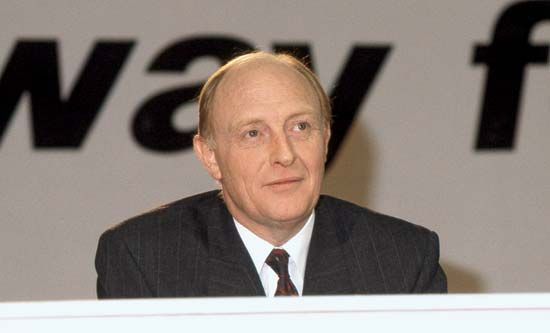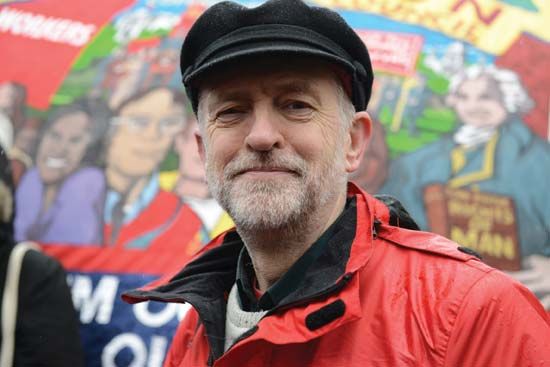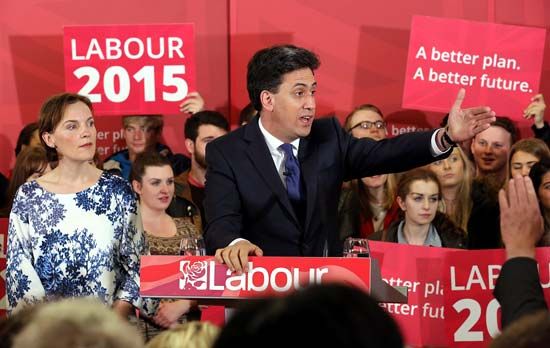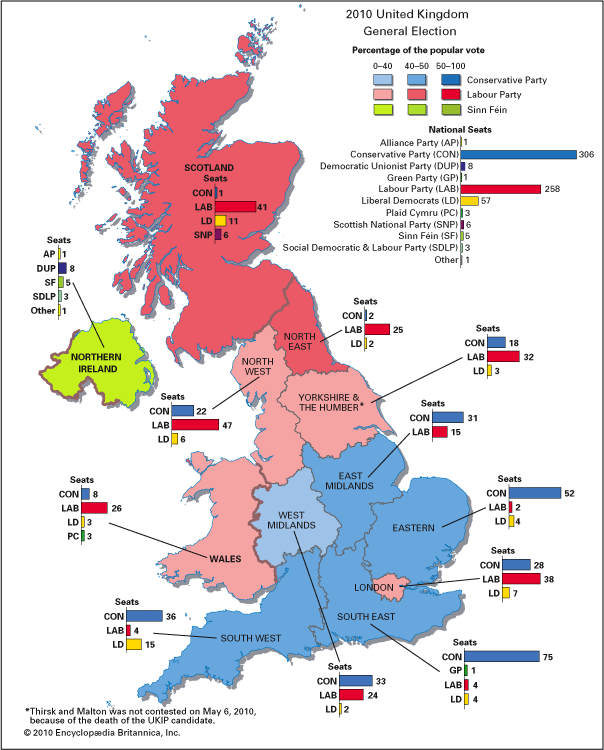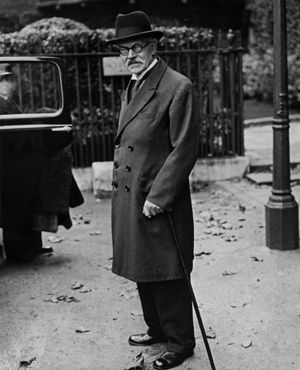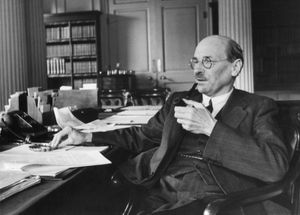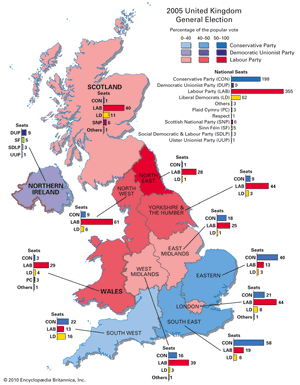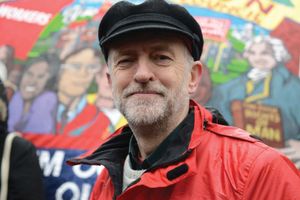Labour Party
- Date:
- 1906 - present
- Areas Of Involvement:
- organized labour
- socialism
- liberalism
- left
- social welfare
News •
Labour Party, British political party whose historic links with trade unions have led it to promote an active role for the state in the creation of economic prosperity and in the provision of social services. In opposition to the Conservative Party, it has been the major democratic socialist party in Britain since the early 20th century.
History
The Labour Party was born at the turn of the 20th century out of the frustration of working-class people at their inability to field parliamentary candidates through the Liberal Party, which at that time was the dominant social-reform party in Britain. In 1900 the Trades Union Congress (the national federation of British trade unions) cooperated with the Independent Labour Party (founded in 1893) to establish a Labour Representation Committee, which took the name Labour Party in 1906. The early Labour Party lacked a nationwide mass membership or organization; up to 1914 it made progress chiefly through an informal agreement with the Liberals not to run candidates against each other wherever possible. After World War I the party made great strides, owing to a number of factors: first, the Liberal Party tore itself apart in a series of factional disputes; second, the 1918 Representation of the People Act extended the electoral franchise to all males aged 21 or older and to women aged 30 or older; and third, in 1918 Labour reconstituted itself as a formally socialist party with a democratic constitution and a national structure. The party’s new program, “Labour and the New Social Order,” drafted by Fabian Society leaders Sidney and Beatrice Webb, committed Labour to the pursuit of full employment with a minimum wage and a maximum workweek, democratic control and public ownership of industry, progressive taxation, and the expansion of educational and social services. By 1922 Labour had supplanted the Liberal Party as the official opposition to the ruling Conservative Party.
In 1924, with Liberal support, James Ramsay MacDonald formed the first Labour government, though his minority administration was brought down less than one year later over questions of its sympathy for the new Soviet state and over alleged communist influence within the party. Labour emerged from the 1929 election as the largest party in Parliament, though again it lacked an overall majority and had to form a coalition government with the Liberals. In 1931 the party suffered one of the severest crises in its history when, faced with demands to cut public expenditure as a condition for receiving loans from foreign banks, MacDonald defied the objections of most Labour officials and formed a coalition government with Conservatives and Liberals. In the ensuing election Labour’s parliamentary representation was reduced from 288 to 52. The party remained out of power until 1940, when Labour ministers joined a wartime coalition government under Winston Churchill.
Labour achieved a spectacular recovery in the general election of 1945, when it won 393 seats and a comfortable 146-seat overall majority in the House of Commons. Most commentators have attributed this victory to the electorate’s overwhelming desire for social reform and its determination to avoid a return to the interwar era of economic depression and unemployment. Under the leadership of Prime Minister Clement Attlee, the Labour governments of the following six years built on the state’s recent experience of wartime intervention to construct a postwar political consensus based on a mixed economy, a much more extensive system of social welfare (including a National Health Service), and a commitment to the pursuit of full employment. Postwar economic recovery proved slow, however, and in the 1950 election Labour’s majority was reduced to five. In 1951 it lost power to the Conservatives.
Throughout the 1950s the question of whether, and how, to adapt the party’s traditional socialist approach to an affluent society—especially the question of the nationalization of industry—divided Labour’s ranks. “Bevanites” (followers of former health minister Aneurin Bevan) wanted a more socialist economic policy and less dependence on the United States; the “revisionists,” led by Hugh Gaitskell, Attlee’s successor as party leader, wished to drop the commitment to the nationalization of industry. Labour did not regain power until 1964 under Harold Wilson, who was prime minister until 1970. Wilson attempted to resolve the problem of Britain’s relative economic decline by pursuing a strategy of technocratic reform, corporatist relations with business and labour leaders, and a system of “indicative” economic planning, in which the government attempted to facilitate economic development in directions of predicted growth. The party held power again from 1974 to 1979, first under Wilson and then under James Callaghan. Labour’s narrow five-seat majority in the election of October 1974 diminished through the term, forcing the party to enter a “Lib-Lab” pact with the Liberal Party. Although hampered by a small majority, the Labour Party pursued controversial policies, including support for Britain’s continued membership in the European Community and devolution in Scotland and Wales, which was rejected by referenda in 1979. Ultimately, the moderate social-democratic approach exemplified by the Wilson-Callaghan years foundered on the twin rocks of Britain’s chronic economic problems and Labour’s worsening relations with its trade union allies.
Following the “Winter of Discontent” of 1978–79, when Britain suffered a series of major strikes by trade unions, the party was ousted from office by the Conservatives under Margaret Thatcher. Subsequently, Labour underwent a period of considerable internal turmoil. Aided by the leaders of some major trade unions, the party’s left wing succeeded in forcing through a number of organizational reforms that enhanced the power of grassroots activists and trade unions in the selection of parliamentary candidates and party leaders. In response, a number of leading parliamentarians and supporters seceded from Labour and founded the Social Democratic Party (SDP) in 1981. In the 1983 general election Callaghan’s successor, Michael Foot, presented a radical manifesto—dubbed the “longest suicide note in history” by Gerald Kaufman, a Labour member of Parliament and critic of the party’s reforms—that proposed extensive nationalization of industry, economic planning, unilateral nuclear disarmament, and the withdrawal of the United Kingdom from the European Community. The result was Labour’s worst national electoral defeat in more than 50 years. Foot was replaced later that year by Neil Kinnock, a politician with leftist credentials who set about reestablishing Labour as a credible national electoral force. Kinnock’s “modernization” process, which involved a reevaluation of party policies and the elimination of extremists—including the Trotskyist wing, Militant Tendency—contributed to Labour’s electoral revival but was not sufficient to deprive the Conservatives of their governing majorities in the general elections of 1987 and 1992. Nevertheless, the process was continued by Kinnock’s successors as party leader, John Smith (1992–94) and Tony Blair (1994–2007). In a series of programmatic and organizational changes, the party reembraced the mixed economy, declared its support for European integration, dropped its unpopular unilateral nuclear disarmament policy, rewrote the clause of its constitution that committed it to the public ownership of industry, and gave serious consideration to a new range of constitutional reforms, including devolution, voting reform, and reform of the House of Lords.
This “New Labour” agenda, combined with highly professionalized political marketing, produced a landslide victory in the general election of 1997, returning Labour to power after 18 years of Conservative Party rule and securing Tony Blair’s appointment as prime minister. Through its policy of All Women Short Lists (AWSLs), the Labour Party dramatically increased the number of women in Parliament; in 1997 it elected 101 women members, nearly 25 percent of all Labour parliamentarians, bringing the total number of women members to a record 120.
With a decisive 179-seat majority in Parliament, the Blair government accepted some of Margaret Thatcher’s policies but also carried out several of the reforms it promised in its manifesto, including abolishing the right of most hereditary peers to sit in the House of Lords and introducing devolved legislative assemblies in Scotland and Wales after successful referenda. It signed the Social Chapter of the Treaty on European Union, which sought to harmonize European social policies on issues such as working conditions, equality in the workplace, and worker health and safety; helped to forge an agreement between Republicans and Unionists in Northern Ireland; modernized the format of “Prime Minister’s Question Time,” during which the prime minister is required to answer questions from the opposition in person; and promised eventual referenda on the introduction of the euro, the European Union’s single currency, and reforms of the electoral system. In 2001 the party won a second consecutive landslide victory, capturing a 167-seat majority—the largest-ever second-term majority for any party in the House of Commons. Despite the party’s electoral success, Blair’s leadership style was often criticized by his Labour opponents as dictatorial. Blair also faced internal dissent over his support for the U.S. policy of military confrontation with Iraq in 2003, when 139 Labour members of Parliament backed an amendment opposing the government’s policy. Nevertheless, in 2005 Labour won its third consecutive general election (albeit with a significantly reduced majority) for the first time in the party’s history. In 2007 Blair resigned the prime ministership in favour of his longtime chancellor of the Exchequer, Gordon Brown. In the subsequent general election of 2010, Labour won 258 seats in the House of Commons and lost its majority. Brown stepped down as leader of the party and on May 11 tendered his resignation as prime minister.
At the Labour Party conference in September 2010, Ed Miliband, with strong union support, edged out his elder brother, David Miliband, the front-runner, to become party leader. Labour rebounded mightily in the 2012 local elections, gaining more than 800 seats in England, Scotland, and Wales, mostly at the expense of the Conservatives, and gained seven seats in the election for the European Parliament in May 2014, edging out the Conservatives for second place but finishing behind the United Kingdom Independence Party.
In the run-up to the general election in May 2015, polling data suggested that Labour and the Conservatives were in a virtual dead heat, but the actual result was a Conservative rout. Labour posted its worst showing since 1987, with several members of Miliband’s shadow cabinet losing their seats outright. Miliband resigned as party leader the following day. In September 2015 Jeremy Corbyn, a left-leaning longtime backbencher, was the surprising victor of the leadership contest in which he captured nearly 60 percent of the more than 400,000 votes cast by rank-and-file supporters.
The May 2016 elections for local governments in England and the national assemblies for Northern Ireland, Scotland, and Wales were a mixed blessing for a Labour Party that had been stung in the lead-up to the voting by accusations that some of its members had made anti-Semitic remarks (at least two members, including former London mayor Ken Livingstone, were suspended from the party in connection with the accusations). Although the party generally held serve in overall terms in council elections in England (losing control of only a clutch of local governments), its fortunes in Scotland continued to ebb as its representation in the Scottish Parliament fell from 37 seats to 24, fewer seats even than the Conservatives. It remained the largest presence in the Welsh National Assembly but, in losing seats, was forced to form a minority government. By far the best news for the party was the triumph of Labour candidate Sadiq Khan in the London mayoral race. Khan became the first Muslim to be mayor of a Western capital.
In the run-up to the “Brexit” referendum on Britain’s continued membership in the European Union, Conservative leaders courted Labour support with the hope that the two parties could jointly make the case for continued association with the EU. Corbyn rebuffed these overtures, and on June 23, 2016, when 52 percent of British voters chose to leave the EU, the result triggered a leadership crisis within Labour. Sitting Labour MPs claimed that Corbyn had not done enough to support the “Stronger In” campaign, and shadow cabinet ministers resigned in droves. Meanwhile, Momentum, a grassroots organization of Corbyn supporters, rallied around the embattled party leader. On June 28 a motion of no confidence in Corbyn’s leadership was passed overwhelmingly by Labour MPs, but Corbyn stated that he had no intention to resign. Corbyn ultimately triumphed in the leadership battle that followed, soundly defeating former shadow secretary for work and pensions Owen Smith in the final vote in late September. About 62 percent of the vote, by party members, affiliated trade unionists, and party supporters who paid £25 to participate, went to Corbyn, compared with about 38 percent for Smith. Having survived that challenge, Corbyn led the party into the snap general election called by Conservative Prime Minister Theresa May for June 2017. Proving himself to be an inspiring campaigner, he steered the Labour Party to a dramatic gain of 30 seats, bringing its total representation in Westminster to 262 seats. Corbyn, however, was perceived by some observers to have led the party too far to the left ideologically, which may have played a role in Labour’s historically poor showing in the 2019 snap election. It won only 203 seats, a drop of 59 seats, its worst national election performance since 1935. In April 2020 Keir Starmer replaced Corbyn as party leader.

